Lupine Publishers | Journal of Environmental & Soil Science
Abstract
The wheels of technology are turned by the conversion of energy from one form into another. Thus, energy is a key element of sustainable development. Current trends in energy supply and use are generally unsustainable, especially when the environment is affected by the emitted green–house gases. These are expected to double by 2050, and increased oil demand will heighten concerns over the security of supplies. Hence, research on green favorites should continue vigorously. It is unfortunate that these have their own limitations. In such a complex situation, consideration of energy priorities in research and development should be organized carefully, and drivers for future energy policy should be considered very critically. This should give very careful foresight for the viable technologies, energy efficiency, renewable energy, oil shale, nuclear energy, hydrogen energy, in addition to any future innovations. Energy is of vital importance for the processes of production and manufacturing. Thus, a key element of sustainable development.
Keywords: Energy Status; Energy Conservation; Oil Shale; Renewable Energy; Hydrogen; Fuel Cells; Energy Efficiency; Innovations
Abbreviations: CCS: Combined Cycle System; CO2 : Carbon dioxide; GHG: Green House Gas; H2 : Hydrogen; HC: Hydrocarbon; HV: Heating Value; HVAC: Heating Ventilation Air Conditioning; ICE: Internal Combustion Engine; JUST: Jordan University of Science and Technology; MED: Multiple Effect Distillation; NPPs: Nuclear Power Plants; PV: Photovoltaic; SHC: Solid Heat Carrier; STPP: Solar Thermal Power Plant; TE: Thermoelectric; TEG: Thermoelectric Generator; UF6: Uranium hexafluoride; UO2 : Uranium dioxide; US: United State
Introduction
With the increase in energy demand and the expected shortage of the fossil fuel with time the need for sustainable resources increases. Hence, this is initially handled by using clean fuels [1], utilization of waste heat [2-6] and adopting different configurations [7,8], where resources and environment are conserved. Energy is of vital importance for the processes of production and manufacturing. Thus, a key element of sustainable development. Energy is the convertible currency of technology. The Wheels of technology are turned by the conversion of energy from one form into another. Currently trends in energy supply and use are generally unsustainable. Energy-related emissions of CO2 are predicted to more than double by 2050, and increased oil demand will heighten concerns over the security supplies. Figure 1 shows the percentage of the (primary) worldwide energy use provided by liquids, natural gas, coal, nuclear and renewables from 2005 through 2035. Renewables include solar and wind power, hydropower, geothermal power, tidal and wave power and biomass.
Liquids, natural gas and coal are collectively the “big three” fossil fuels that emit GHGs when converted to energy. They constitute about 81% of the worldwide primary energy. The actual amounts of energy used by source are shown in Figure 2 [9].
Figure 3 shows the importance in assessing the GHG nature of a regional economy, it’s given by CO2 / Energy Ratio (in metric tons of CO2 /GWh, GWh= 106 kWh) which Figure 4 shows the Global Market, Cumulative Installed capacity by Technology. There are certain “Green” favorites, such as solar, wind and biomass with limitations in capturing and storing, fluctuation, high cost, and being nonintensive. There are many exciting variants on nuclear power which face significant risks of cost overruns, limited investment, safety and health hazards. Petroleum and natural gas are currently the main sources of energy. But the combustion of these hydrocarbons contributes a large fraction of green-house gases and air pollutant emissions. The search for an alternative fuel that provides as much energy and is environmentally friendly has been a quest for quite sometimes [10].
Figure 3: Annual CO2 / Energy Ratio (in metric tons of CO2 /GWh, GWh= 106 kWh) in 2005-2035 for United States, India, China, and the World [10].
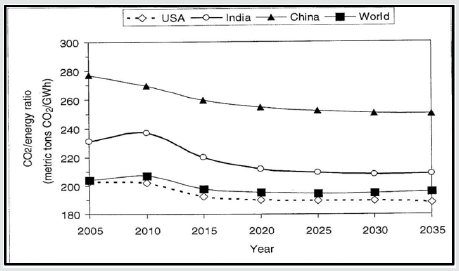
Energy Status
Unfortunately, some countries import almost all of its energy needs. In view of the increasing burden imposed by energy imports, it is critical for them to look for indigenous sources of energy. Switch to new, highly efficient and environmentally superior energy technologies, is highly desirable. Relative contribution of energy sources in the total energy mix over the period (2005-2020) is show in Table 1, for a typical developing country. The typical distribution of final energy (2000-2005) is shown in Table 2. Using energy has a direct impact on environment due to:
a) Effluent gases [11].
b) Warming and climate change
Viable Technologies
Viable Technologies and Resources:
a) Combined cycles [12] and cogeneration (Figure 5) [13-21]
b) Energy conservation
c) Oil shale
d) Renewable energy
e) Nuclear power
f) Hydrogen and Fuel Cells
Energy Conservation
Fossil fuels are at present, and will be for the following decades, the primary source of energy for satisfying the region’s energy demands. However, CCS already faces many challenges that are not only related to issues such as financing demonstration projects and integration of adequate infrastructure, but also to efficiency [22- 24]. For example, capturing and compressing CO2 would increase the fuel needs of a coal-fired powered plant by 25-40 percent. Therefore, efforts should be forwarded toward:
a) Utilizing higher power plant conversion efficiency (combined cycle).
b) Exploitation of low C/H content fuels, such as natural gas.
Oil Shale
The rise of oil prices in the global market has increased the interest in production of oil from oil shale in Estonia and other countries as well. The greatest problem of shale oil production is the low thermal efficiency of the process [25]. Figure 6 shows the theoretical (retorting in standard Fischer Assay) energy balance of thermal decomposition of oil shale organic matter, as well as the real-life balance compiled based on the long-term experience of shale oil production with the solid heat carrier (SHC) method at the AS Narva Oil Plant Company [26]. Oil shale is a kerogen-rich fine-grained sedimentary rock and its abundant reserves are the second largest among all fossil fuels in the world if converted into heat [27-30].
Figure 6: Energy balance of thermal decomposition of oil shale organic matter. Theoretical means energy balance by retorting in standard Fischer Assay.
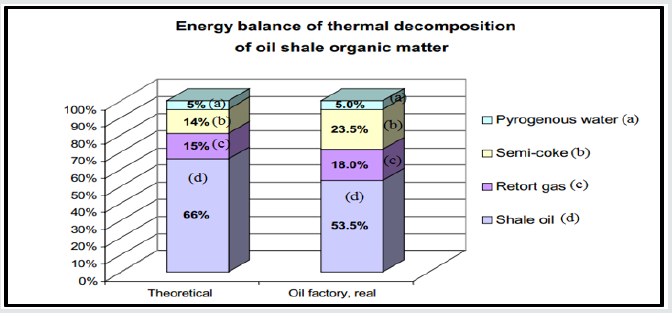
Oil Shale needs more detailed studies that handle [31-33]:
a) Realistic quantification.
b) Appropriate Technology.
c) Economics of conversion.
Jordan contains 40 billion tons of oil Shale (30 years), Each ton oil shale contains 80-100 kg oil where Sulfur content about 4%. The heating value= ¼ HV of HC fuel, Hence one ton oil shale =0.025 ton of HC fuel but, it’s harmful to the environment(Open Pit Mining),results in barren land and it has a high consuming of water: one barrel oil needs one barrel water plus intensive energy consuming (In-situ retorting):3 barrels of oil need one barrel of fuel [34,35].
Renewable Energy
Renewable energies are sources of energy that are regenerated continually from nature and derived directly from the sun (such as thermal, photo-chemical, and photo-electric), indirectly from the sun (such as wind, hydropower, and photosynthetic energy stored in biomass), or from other natural movements and mechanisms of the environment (such as geothermal and tidal energy). Renewable energy does not include energy resources derived from fossil fuels, waste products from fossil sources, or waste products from inorganic sources [36]. Figure 7 shows an overview of renewable energy sources [37,38].
While it is true that renewable energy sources are environmentally friendly, or “green”, one has also to consider their feedstock. Solar, wind, hydro, biomass and geothermal energies are “free” at first glance, although they require huge land-use investments with environmental unfriendly footprints especially biomass. However, active research and development should continue until RE become competitive on all grounds, to increase their share in the total energy profile due to their own merits, not due to subsidies. Renewables account for 8% of the (world) and US national energy product as Figures 8 & 9. Most of this market is not due to symbolic renewables of wind and solar that dominates global discussion [39]. It is from biomass and hydroelectricity. It is also obvious that electricity from renewable energies has considerable problems in the way they are deployed today. First of all, and foremost, they are dependent on certain conditions (availability of wind, water and sunshine). Due to their intermittent nature, this deployment method is overstraining the grid, which is additionally rather inefficient in itself e.g. Germany. This not only requires improving the grid, but also making it “smart”.
Figure 8: U.S renewable energy consumption (by source) 2003. The generation of electricity accounts for about one-half of the renewable resources used.
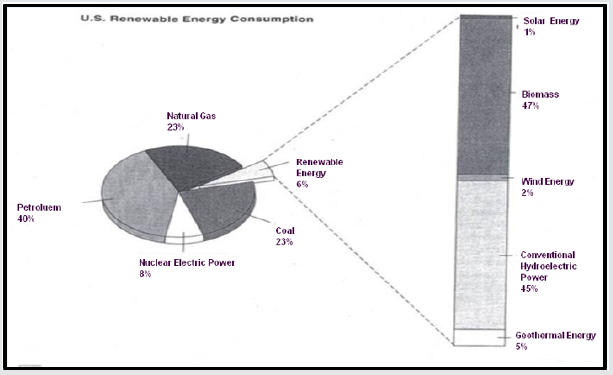
Figure 9: U.S renewable energy consumption (by source) 2003. The generation of electricity accounts for about one-half of the renewable resources used.
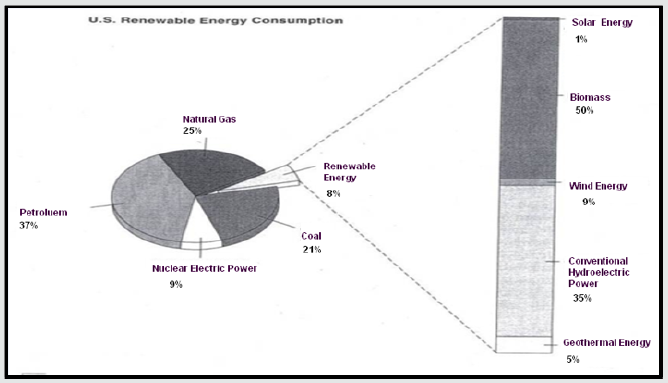
Renewable Energy (RE) - Wind
At the end of 2008, the worldwide capacity of wind-powered generators added up to 121 GW, a mere of 1.5 percent of the world’s electricity usage. But the rapid growth continues, with China doubling its wind power capacity for the fifth consecutive year since 2004 [40]. The strongest growth will be biomass and wind towards (2035). The solar remains the perennial dark horse with tremendous but unproven potential. Intermittency of wind turns out to be a big problem for the grid-operating utilities, because electricity must be used as soon as it is produced. But how easily can be forecast when and where the wind will blow? You can’t simply start a wind mill up when you need it most. Thus, at least as the electricity grids are operated today, the intermittency of wind always requires backup systems (batteries) with an equal amount of dispatchable generation capacity. Unfortunately, at the moment these back-up systems are mostly conventional power plants that do not have short run-up times. In addition to the unpredictability of wind, wind farms usually need high investments to be built, and are also very expensive to properly maintain. At least 20 percent of the windmills are shut off for maintenance or repairs. What is even worse, they are often taken off the grid, because their electricity is not needed at that given moment [41,42]. There are no commercially viable ways to store wind energy at this time, other than pumping up water electrically in water reservoirs. But this only makes sense when wind farm and water reservoir are close to each other. Moreover, wind has noise emission, effect on animal species and birds. There are objections by the military: disturbing microwave lengths, radar and low-flying aircrafts [43-45].
Renewable Energy- Solar
The amount of energy that comes from the sun is phenomenal: If we could somehow gather all the energy that reaches the earth on one day and store it, it would supply the energy needs of the whole world for almost 30 years. Moreover, solar radiation is actually the sole source for fossil or renewable energy that we use today. Electricity from sunlight can be generated directly using photovoltaic solar cells, or indirectly as with concentrating solar power [46-48]. Consider another interesting aspect: PV solar cells convert the sun’s radiation into DC power on which most of our appliances actually run [49]. But this power is converted into AC power by inverters and fed into the inefficient grid, only to be inverted again to DC [50]. At this point, the most cost-effective and efficient technology for converting solar power into electricity are huge solar-thermal power plants (Figures 10 & 11). Here, sunlight is gathered by a large solar-collecting field with parabolic mirrors, so called troughs. These collectors track the sun over the course of the day and concentrate the sunlight onto absorber pipes where the radiation is converted into heat. A heat transfer fluid which is circulating through the pipes is heated up to temperatures of almost 400⁰C [51,52]. The heat is used to generate vapor or steam with which electricity is then produced by conventional turbines. The process fluid or water is then cooled and returned to the cycle. The surplus heat could be used for heating, desalination, cooling, air conditioning, and other applications, but in most cases, it is currently rejected to the atmosphere. Solar-thermal power plants have been in commercial use for several decades since (1982). Thermal molten salt storage enables electricity production even during the night, or on cloudy days. The storage time, however, is estimated to be seven hours.
Water is mainly used for cooling the steam circuit, i.e. from the vaporization of water in the cooling towers (about 1 million tons water/y for 150 MW plant, 400 sq km). So, the plant operators not only have to capture the power of the sun, but also need immense amounts of water for cooling the heat transfer media. As most solar power plants today is located in deserts, this physical necessity may be an obstacle to development on the long run [53,54].
Nuclear Energy
There is now a plenty of uranium, that present reactors can supply energy for some hundreds of years, where fossil fuels are expected to run out in a few decades. So nuclear energy may be considered semi-sustainable.
Using nuclear energy is assumed to limit the pollution with greenhouse gases in an efficient and cheap way. It is the only alternative to provide clean energy on a massive scale. However, nuclear energy has the problem of accidents and there is still no proper solution to store nuclear waste in a safe way [55]. Some consider nuclear power plants to be a “clean” electricity source, since the plants themselves do not directly emit CO2 and other GHGs. Nevertheless, the operation of nuclear power plants results in the immense environmental impacts which are displayed in Figure 12. After a cost intensive exploration process, uranium ore is recovered from the earth’s crust under quite difficult conditions. It must be extracted from the mined ore using strong acids and bases, and then be converted into either uranium dioxide (UO2 ) for heavy water reactors or gaseous uranium hexafluoride (UF6 ) for light water reactors [56].<.
Most reactors require uranium fuel to have a U-235 (an isotope of uranium) content of 3 to 5 percent. For this step, large amounts of electricity, mostly provided by fossil fuel plants, are needed to increase the actual concentration of 0.7 percent to 3 to 5 percent. Afterwards, the uranium is manufactured into fuel pellets by pressing powdered UO2 or UF6 into cylindrical shapes and baking them at high temperatures, usually between 1,600 and 1,700⁰C. Finally, energy is released in a reactor by controlled nuclear fission reactions just to boil water, produce steam and drive a turbine that generates electricity. This process alone has an efficiency of only 35 percent. For steam production and for cooling, approximately 2.5 times more water is needed for nuclear than is required for fossil fuel plants. This is the reason why nuclear power plants are located at rivers or lakes. In 2008, KIKK German committee reported a 60% increase in solid cancer incidence and a 120% increase in Leukemia incidence among children living within 5 km of all German nuclear power stations [57]. In essence, this suggests that doses to embryos/fetuses in pregnant women from environmental emissions from nuclear power plants (NPPs) may be larger than suspected. It is now officially accepted in Germany that children living near nuclear power plants develop cancer and leukemia more frequently than those living further away [58].After the nuclear fuel is consumed in the reaction process, it is removed from the reactor and stored on site in large water-filled pools for about five years. Later, the radioactive waste is transferred to underground caverns for medium-term storage. At present, there are no safe disposal facilities in operation anywhere in the world which can accept radioactive waste for permanent storage [59]. In a radioactive waste disposal facility since the seventies, the storage has recently been found to be unstable. According to World Nuclear News, roughly 126,000 barrels filled with lowlevel radioactive waste including contaminated clothes, paper and equipment need to be brought to the surface for alternative storage [60,61]. A challenge involves approximately Euro 3.7 billion and a rather gracious heritage for future generation(s). We always need to keep in mind that already a minor failure in a nuclear power plant can create severe consequences for all forms of life on earth. Accordingly, decision makers should answer the question: How much “clean” a process like this that poses health risks exceeding that of any other process of electricity generation?
Hydrogen and Fuel Cells
The key criteria for an ideal alternative fuel are inexhaustibility, cleanliness, convenience, and independence from foreign control. H2 is considered as one of the most promising fuels for generalized use in the future. Mainly because it is versatile, energy-efficient, low-polluting, and a renewable fuel. Hydrogen is environmentally favorable replacement for gasoline, heating oil, natural gas, and other fuels in both transportation and industrial applications [62-65]. In nature, mostly the hydrogen is bound to either oxygen or carbon atoms. Hence, to obtain hydrogen from natural compounds, energy expenditure is needed [66-71]. Therefore, hydrogen is considered as an energy carrier a means to store and transmit energy derived from a primary energy source. Presently hydrogen is mainly used in production of gasoline, fertilizers and metals. However, hydrogen requires energy to produce, store and distribute. Hence, hydrogen technologies need to be developed to reach the stage of competing with fossil fuels and other alternatives to produce power [72-75]. These technologies should emphasize efficient systems to reduce energy losses, and emissions. Among high efficiency technologies, fuel cells appear to be the most promising with high efficiency and very low environmental impact. Fuel cells are able to convert the fuel chemical energy into electricity, heat and water by reverse electrolysis. This leads to much higher conversion efficiency [76].
Fuel cells can convert the fuel chemical energy into electricity, heat and water by reverse electrolysis, Figure 13. This leads to much higher conversion efficiency. Both considerable primary energies saving and pollutant reduction, are achieved by upgrading conventional systems to fuel cell hybrid plants, Figure 13. Oil is essential in the transport sector while natural gas will become a more dominant fuel in power generation. Hydrogen economy is expected to offer considerable opportunities. Fuel cell development is an important step to the efficient use of hydrogen hence, research must continue in this area, Figure 14. The preferable solution is to produce H2 from sustainable sources such as, wind energy, solar energy, waterpower or biomass. However, these energies will not be able to provide a massive contribution to meeting the energy demand for many decades to come: Environmental reasons (large scale tolerance of wind energy), practical reasons (availability of surfaces), economic reasons (cost of photovoltaic energy) and technological reasons (storage of intermittent energies) [77]. Hence, the fuel cell is seen to be the most efficient energy converter in the near future, using H2 . However, it still has major problems, such as: Reducing the cost of fuel cells by a factor of 90%; enhancing the performance and durability of fuel cell systems by a factor of 2, and reducing the H2 production and distribution costs by a factor of 3 productions from water is not efficient [78].
Energy Efficiency
Energy efficiency is a convenient technology to be adopted by the developing countries. Energy conservation implies reductions in the consumption of energy, such as (turning thermostats down) [79]. Consuming less energy results in protection of the environment and preventing climate change through forcing people to make sacrifices in comfort, pleasure and convenience. Efficiency implies obtaining more useful heat, or work from each unit of energy supplied, either by technological improvements or reducing waste. Consuming less energy results in protection of the environment and preventing climate change through forcing people to make sacrifices in comfort, pleasure and convenience [80]. Hence, Energy efficiency could be described in three ways: Less energy for the same benefit (conservation), the same energy for a greater benefit and more energy for an even greater benefit. Only the first description of energy efficiency is sustainable. The second does not lower gross energy use, and the third increases it [81]. If promoting energy efficiency, enhances the benefits of the end users, and does not reduce the impact of energy and environmental costs, this is not sustainable. Improved energy efficiency must lead to measurably less gross energy use (reduced use of fossil fuels) and polluting emissions. Improved “energy efficiency technology “involves much more efficient: motors, air conditioners, furnaces, direct and indirect water heaters and computers [82,83].
Variable speed drives and variable volume HVAC with direct digital control, energy management systems with optimal start, cogeneration and air-to-air heat pumps, reduce use of electricity and fuel in commercial buildings [84]. For transportation, to have lighter aluminum blocks, fuel injection, turbo charging, overhead cams, automatic speed controls, and using unleaded fuel with catalytic converters to reduce emissions. The bodies and frames of the cars need to become lighter, smaller and more unified. They are made lighter with plastics and fiberglass shaped into aerodynamic forms. Moreover, steel belted radial tires, front wheel drive, disk brakes with anti-lock features, light emitting diodes, all yields a better efficiency [85]. Interstate highway systems, speed limits legalized, carpooling, and most recently, the internet, email, and telecommuting reduced gasoline consumption and improved energy efficiency. In Power industry: combined cycles, cogeneration systems, trigeneration: of power, heating and cooling enhance energy efficiency. One-third of the oil used in most countries is used in transportation, by passenger cars and light trucks. The overall fuel efficiency of vehicles could be increased by improvements primarily in aerodynamics, materials, and electronic control [86].
The most fuel-efficient cars are compact with small engines, manual transmission, low frontal area, front wheel drive and reduced vehicle weight. Radial tires usually reduce the fuel consumption by 5 to 10 percent by reducing the rolling resistance.
i. Before driving:
a) Using fuel with the recommended minimum octane number; not overfilling the gas tank.
b) Parking in the garage.
c) Starting the car properly and avoid extended idling.
d) Not carrying unnecessary weight in the vehicle.
e) Keeping tires inflated and the wheels aligned.
ii. While driving:
Avoiding quick starts and sudden stops:
a) Driving at moderate speeds.
b) Maintaining a constant speed; avoiding sudden acceleration and sudden braking; avoiding resting feet on the clutch or brake pedal while driving.
Using highest gear (overdrive) during highway driving; turning the engine off rather than letting it idle; and using the air conditioner sparingly. Regular maintenance improves performance, increases gas mileage, lowers repair costs, extends engine life and reduces air polluting [87].
Innovations in Energy Systems
The automobile industry and the associate industries that serve as the base of the world’s economy and employ the greatest share of the working population. They have played a significant role in the growth of modern society by satisfying the need for mobility in everyday life [88]. Presently, all vehicles rely on the combustion of hydrocarbon (HC) fuels to derive the energy necessary for their propulsion. Recent European green car initiatives are concentrating on advanced internal combustion engine (ICE) research with emphasis on:
a) new combustion techniques such as stratification with direct injection in gasoline engines,
b) using alternative fuels (bio-methane, ethanol, hydrogen etc.),
c) intelligent control systems,
d) mild hybridization and
e) special tires for low rolling resistance [89].
A smart Controller for improving fuel economy in vehicles was adapted with fuel saving ~ 11% ) (Figure 15). Considering recent fuel prices, a country of (6M people)can save: 60.0 M JD/y. The Environment is saved proportionally, from CO2 , Figure 3.
1.3 billion People – about 20% of the worldwide population – are still without access to electricity, almost all of whom live in developing countries [90]. Providing a minimum amount of electricity can actuate the basic needs such as light, radio and some medical electronic devices. Thus, making a lot of difference in their lives. TEG coupled to the stove can be a very interesting option to provide such amount of electricity. TEG is a device that harvests waste energy and converts some of it to useful power. It operates on a fundamental principle termed the See beck effect which states: when a temperature gradient is established between two different metals or semiconductors, a corresponding voltage gradient is induced. This causes a continuous current to flow through a complete circuit. The major advantage of a TE generator in this case is requiring almost no maintenance, since there are no moving parts. Only the battery needs to be charged when needed. The TE generator works day and night in clear or rainy weather unlike solar panels. Moreover, the battery does not need to be oversized. On the other hand, there are some challenges involved in using the thermoelectric generators. Mainly the low efficiency of the technology itself is below about 10% [91] and the high price of the TEG models. The low efficiency problem may be solved by new technologies evolved over time. The price will decrease with more adoption of such systems. Figure 16 shows a typical TE stoves which offers multitasks simultaneously such as: Space heating, cooking, heating water and generating electricity for basic needs. Moreover, generation of water is planned in the near future [92].
Figure 16: Cross sectional view of the JUST stove [92]. Where: Tg1: Gas temperature at position 1; Tc4: Thermocouple at position 4; Tg2: Gas temperature at position2; Tc5: Thermocouple at position 5; Tg3: Gas temperature at position 3; A1: Combustor zone; Tg4: Gas temperature at position 4; A2: After combustor zone; Tc1: Thermocouple at position 1; A3: After TEG fins zone; Tc2: Thermocouple at position 2. A4: After cooker zone; Tc3: Thermocouple at position 3; A5: The stack.
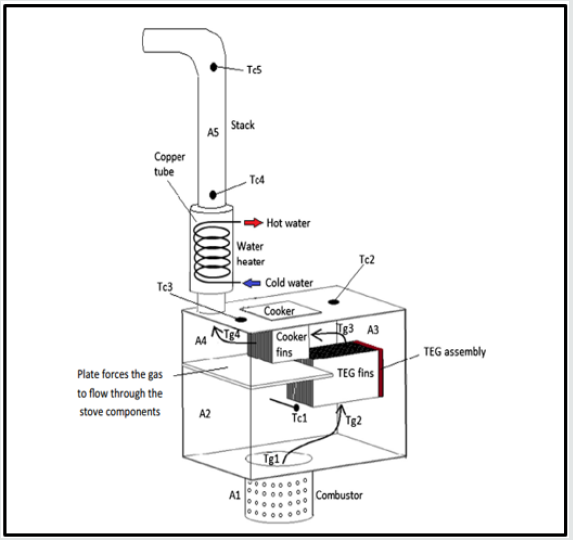
Conclusion
Viable Technologies
Combined cycles, cogeneration, natural gas, fuel cells and energy efficiency: Contribute toward sustainability.
Power Generation:
Presently, concentration should be made on energy efficiency technologies. In the future, on fuel cells.
Oil Shale Needs
a) Realistic quantification
b) Appropriate technology
c) Economics of conversion: (requires huge amounts of fuel and water)
d) Genuine assessment of environmental impacts Renewable Energy
Green Favorites, although clean they have limitations in capturing and storing, fluctuation, high installation cost, and are non-intensive when converted. Active present and future research should proceed continuously, supported by all means possible, until RE become really competitive on all grounds, to share a progressively higher portion of the energy pie, with gradual replacement of fossil fuels.
Nuclear Energy
a) The nuclear energy has the problems of health hazards (during operation), storing waste, escalating initial cost, and accidents.
b) The risks of nuclear energy are too high for ourselves and the many generations to come.
c) Hence, the nuclear energy should not be an easy way for some policy makers to ensure enough energy in the future.
Hydrogen and Fuel Cells
More research and development should be concentrated on hydrogen. Mainly because it is versatile, energy-efficient, lowpolluting, and a renewable fuel.
a) A hydrogen car is safer than NG or gasoline car in collisions in open spaces.
b) But as safe as NG car and safer than gasoline or propane car in a tunnel collision.
c) However, H2 economy needs more efforts to reduce the cost of: FC, H2 production and distribution; plus, durability enhancement.
Energy Efficiency,
a) Energy efficiency is a convenient technology to be adopted by the developing countries.
b) Consuming less energy results in protection of the environment and preventing climate change.
c) Efficiency implies obtaining more useful heat, or work from each unit of energy supplied, either by technological improvements or reducing waste.
Innovations in Energy Systems
Innovations in energy systems should continue and more devices developed to enhance energy efficiency and sustainability
Acknowledgment
The author would like to thank Engineers Duaa MH Kharouf and Ahmad Abu-baker for the valuable help.
Read More About Lupine Publishers Journal of Environmental & Soil Science Please Click on Below Link:
https://lupine-environmental-soil-sciences.blogspot.com/

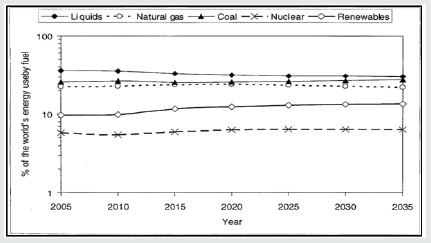
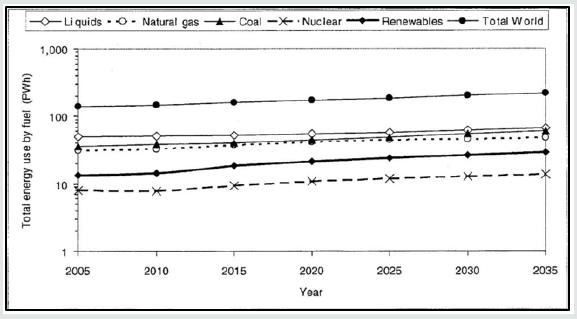
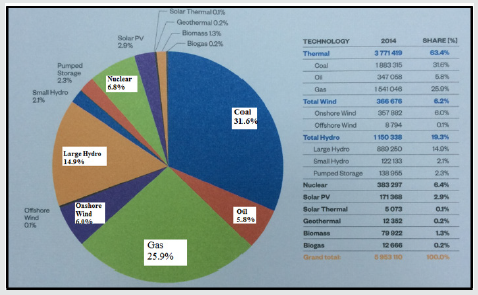

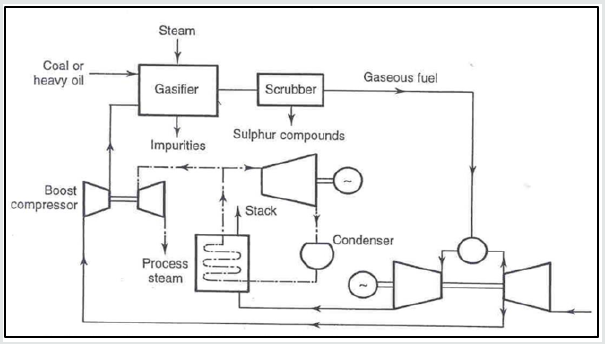
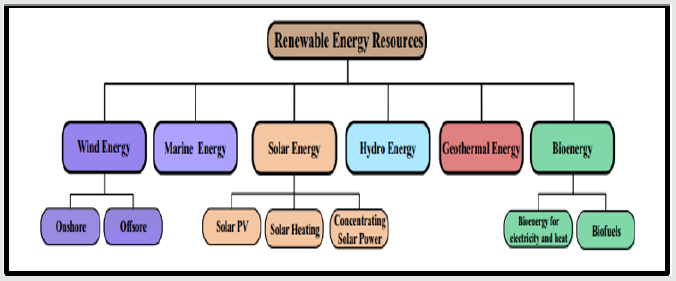
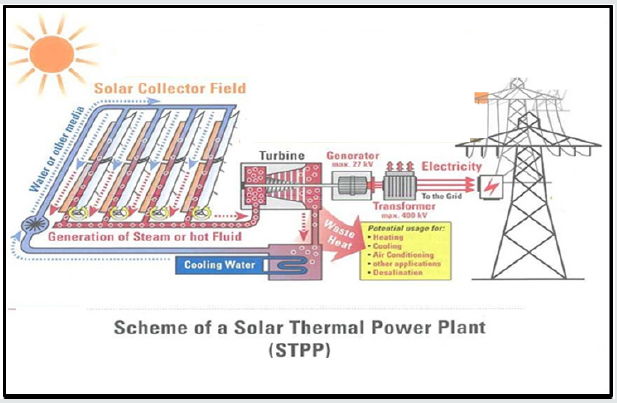
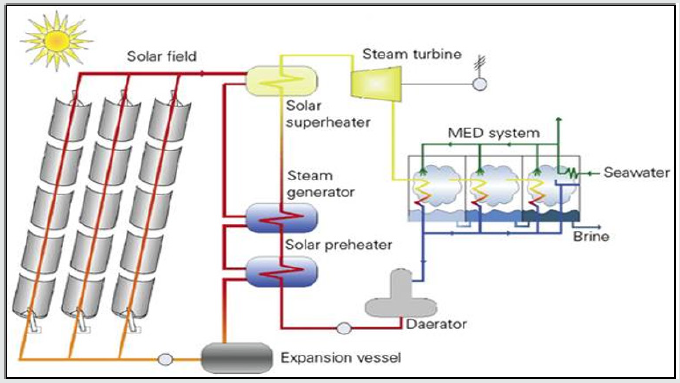
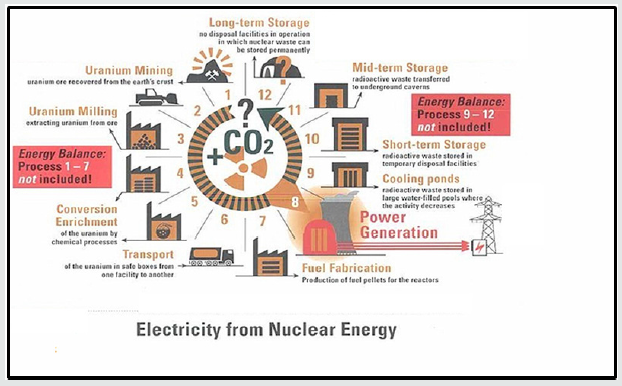
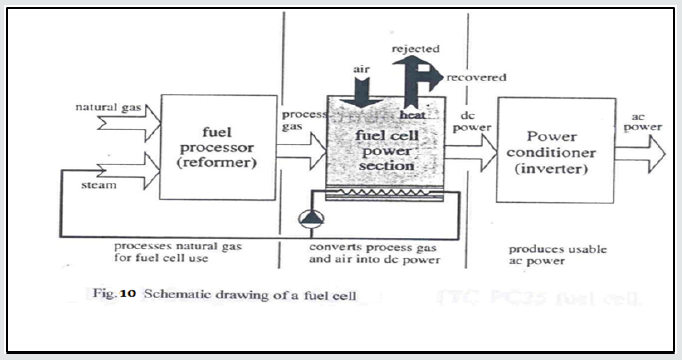
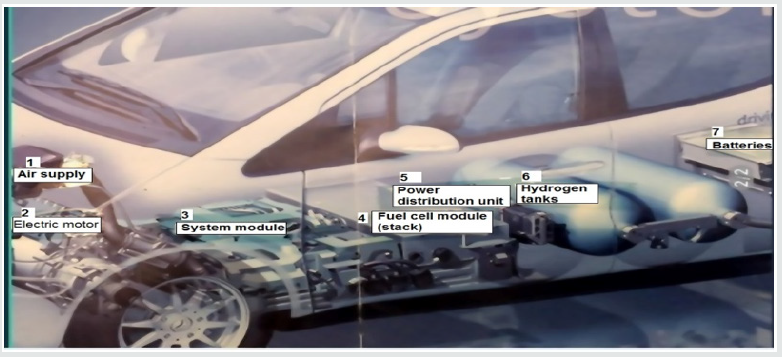
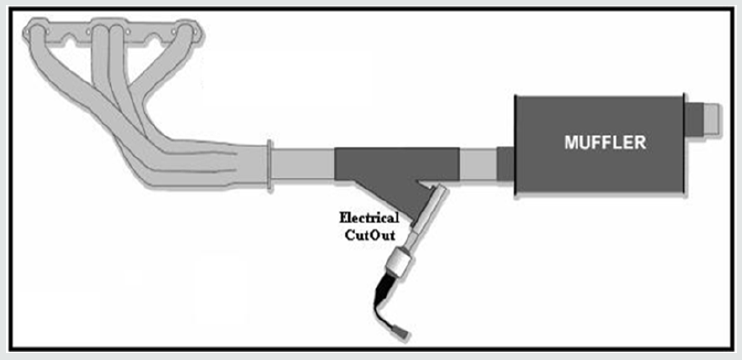
No comments:
Post a Comment
Note: only a member of this blog may post a comment.